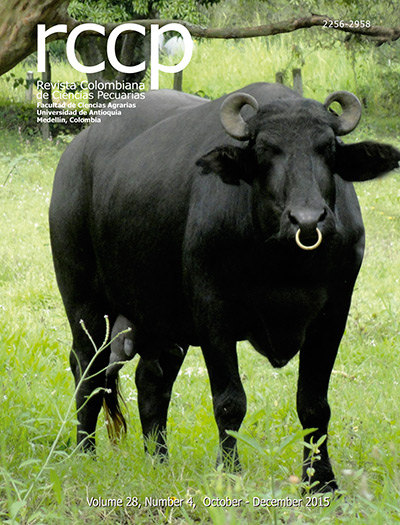Ideal ratio of digestible methionine plus cystine to digestible lysine for growing Japanese quails
DOI:
https://doi.org/10.17533/udea.rccp.324937Keywords:
Coturnix japonica, ideal protein, productive performance, sulfur amino acidsAbstract
Background: methionine is considered essential for maintenance, growth, and feather development. Methionine supply during the growth phase can influence the weight at sexual maturity and egg size. Objectives: to evaluate the effects of several digestible methionine + cystine/digestible lysine ratios for growing Japanese quails (1 to 40 days of age) with repercussions on the early stage of production (41 to 110 days of age). Methods: a total of 1,000 one-day-old Japanese quails were randomly distributed to five digestible (methionine + cystine)/digestible lysine ratios, with 10 replicates and 20 birds per experimental unit. A basal diet formulated to meet all nutrient requirements was added with graded levels of DL-methionine replacing glutamic acid. Results: weight of the birds at 40 days, weight gain until 40 days, feed intake, carcass weight, fat, and bodyprotein deposition, methionine + cystine intake and birds viability in the growing phase presented a linear trend. A quadratic effect was observed for feed conversion and uniformity at 40 days of age, and percentage of feathers did not vary. A linear increase occurred in the laying phase for feed intake and weight gain of the birds. No effects of the assessed ratios were observed on the other variables. Conclusions: a 0.73 ratio of digestible (methionine + cystine) to digestible lysine in the growing phase provided uniform growth and satisfying performance of Japanese quails during the laying phase.
Downloads
References
AOAC (Association of Official Analytical Chemists). Official methods of analysis, 17nd ed., Gaithersburg (MD): AOAC International Publishers; 2000.Leeson S, Summers JD. Commercial poultry nutrition. 3nd ed. Guelph (Ontario): University Books Publishers; 2005.Lima HJD, Barreto SLT, Melo DS. Diferentes pesos corporais ao final da fase de recria sobre o desempenho produtivo de codornas japonesas. Encicl Biosf 2011; 7:404-409.Mandal AB, Elangovan AV, Tyagi PK. Effect of enzyme supplementation on the metabolizable energy contento of solvent-extracted rapeseed and sunflower seed meals for chicken, guinea fowl and quail. Br Poult Sci 2005; 46:75-79.NRC (National Research Council). Nutrient requirements of poultry. Washington (DC): National Academy Press; 1994. Oliveira BL. Importância do manejo na produção de ovos de codornas. Proceedings of the 2th Simpósio internacional de coturnicultura;2004; Lavras, Brasil. Lavras: UFLA; 2004.Pinto R, Ferreira AS, Donzele JL, Albino LFT. Exigência de metionina mais cistina para codornas japonesas em crescimento. Rev Bras de Zoot 2003; 32:1174-1181.Reis LFSD. Codornizes, criação e exploração.Lisboa: Agros Publishers; 1980.Rostagno HS, Albino LFT, Donzele JL, Gomes PC, Oliveira RF, Lopes DC, Ferreira AS, Barreto SLT, Euclides RF. Tabelas Brasileiras para Aves e Suinos:Composição de Alimentos e Exigências Nutricionais. Viçosa Publishers; 2011.SAS INSTITUTE. SAS/STAT: user ́s guide. Version 9.4. Cary: SAS Institute, 2014.Silva JHV, Costa FGP. Tabelas para codornas japonesas e europeias. 3nd ed. São Paulo: Funep Publishers, 2009.Singh RV, Narayan R. Produção de codornas nos trópicos. Proceedings of the 1th Simpósio internacional de coturnicultura;2002; Lavras, Brasil. Lavras: UFLA; 2002.Svacha A, Weber CW, Reid BL. Lysine, methionine and glycine requirements of Japanese quail to five weeks of age. Poult Sci 1970; 49:54-59.Vercese F. Efeito da temperatura sobre o desempenho e a qualidade dos ovos de codornas japonesas. [Msc Thesis]. São Paulo: Universidade Estadual Paulista; 2010.Vohra PA. Review of the nutrition of Japanese Quail. World Poult Sci J 1971; 27:26-33.
Published
How to Cite
Issue
Section
License
Copyright (c) 2016 Revista Colombiana de Ciencias Pecuarias

This work is licensed under a Creative Commons Attribution-NonCommercial-ShareAlike 4.0 International License.
The authors enable RCCP to reprint the material published in it.
The journal allows the author(s) to hold the copyright without restrictions, and will allow the author(s) to retain publishing rights without restrictions.






